Subjects:
- Length
- Surface
- Content
Height:
Length is a one-dimensional measure. We can measure the length of all kinds of objects. We express the size of this object in a unit of length. The unit of length is also known as the measure of length. The ruler in the picture below measures a length of 5 cm.

The length measure can be expressed in, among others, the following units:
- millimeters (mm)
- centimeters (cm)
- decimeters (dm)
- meters (m)
- decameter (dam)
- hectometre (hm)
- kilometers (km)
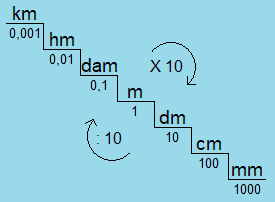
Between each unit of length the step is a factor of 10. From largest to smallest we have to multiply by 10 and vice versa divide by 10.
In the image above it can be seen that 1 meter equals 0,001 km and 1000 mm.
From smallest to largest is times 10.
mm -> cm -> dm -> m -> dam -> hm -> km
From largest to smallest is dividing by 10.
km -> hm -> dam -> m -> dm -> cm -> mm
Surface:
Area is a two-dimensional measure. We express the area of a given area or object in a unit of area. The area is calculated by multiplying the length by the width.
An object with a length of 8 by 5 centimeters has an area of (8*5) = 40 cm².
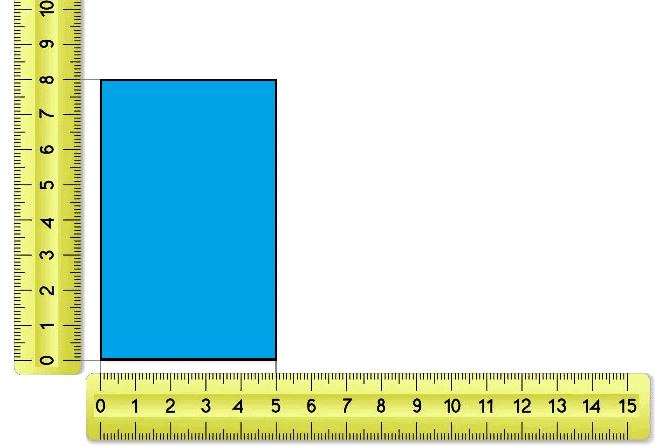
- square millimeters (mm²)
- square centimeters (cm²)
- square decimeter (dm²)
- square meters (m²)
- square decameter (dm²)
- square hectometers (hm²)
- square kilometers (km²)
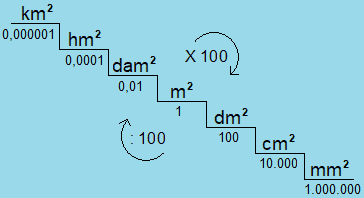
In automotive technology, for example, we are dealing with the frontal area of a passenger car that is 1,9 m². This is equal to 19000 cm².
From smallest to largest is times 100.
mm² -> cm² -> dm² -> m² -> dam² -> hm² -> km²
From largest to smallest is dividing by 100.
km² -> hm² -> dam² -> m² -> dm² -> cm²-> mm²
1 hm² = 1 ha.
A square hectometer (hm²) is also referred to as a hectare (ha). One hectare is an area of 100 x 100 meters and is equal to 10.000 m².
1 dam² = 1 are.
A square decameter (dam²) is also called an are. One are equals an area of 100 m².
Content:
Content is a three-dimensional measure. With regard to the content, we are dealing with the length, width and depth. Multiplying the length, width and depth gives the content. A cube with a length of 7 cm, a width of 8 cm and a depth of 8 cm has a volume of: 7*8*8 (l*w*h) = 448 cm³.
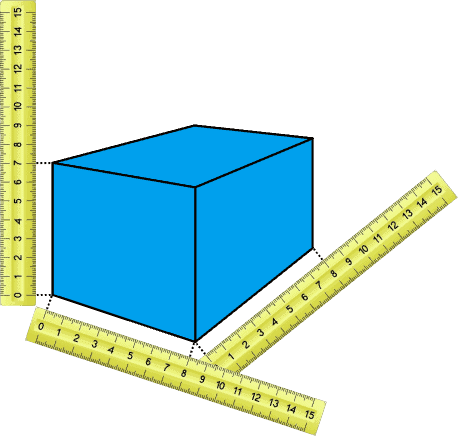
- cubic millimeters (mm³)
- cubic centimeters (cm³)
- cubic decimeter (dm³)
- cubic meter (m³)
- cubic decameter (dm³)
- cubic hectometers (hm³)
- cubic kilometer (km³)
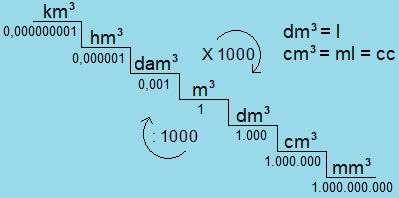
From smallest to largest is times 1000.
mm³ -> cm³ -> dm³ -> m³ -> dam³ -> hm³ -> km³
From largest to smallest is dividing by 1000.
km³ -> hm³ -> dam³ -> m³ -> dm³ -> cm³-> mm³
1 cm³ = ml = cc.
In car technology, for example, we are dealing with the cylinder capacity of an engine that is 1988 cm³. This is equivalent to 1988 ml and 1988 cc.
cm³ to dm³ = liters.
Looking at the table, the multiplication factor between cm³ and dm³ is 1000. If we convert cm³ to dm³, we get 1,988 dm³ which is equal to 1,988 liters.
